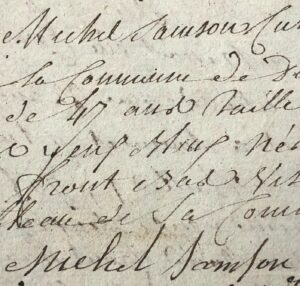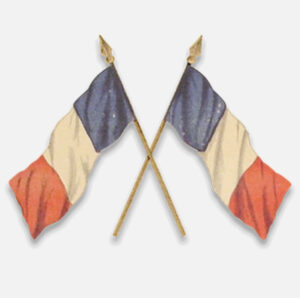This article presents the graves of British soldiers in the Blosseville cemetery, after having briefly retraced the history of the battles in which they perished. Another article is devoted to the memory of French soldiers.

Twelve soldiers, in total, lost their lives in the territory of the commune of Blosseville sur Mer on June 10 and 11, 1940.
These twelve men, most of them very young, showed the same courage and suffered the same tragic fate in a common battle. They are therefore united in our memories and our commemorations honour them all together.
The distinction made on this website between the four French soldiers and the eight British who fell in combat in our village is explained by the history of their burials..
After their death, all were buried in the Blosseville cemetery. In 1948, the remains of French soldiers were returned to their villages of origin. Any visible trace of their years in the cemetery had therefore disappeared until the installation in June 2023, on the war memorial of a commemorative plaque, citing their names1The installation of this plaque was done by the municipality of Blosseville. This initiative, also carried out in other municipalities, follows the resolute and persevering action of Mr Hervé Savary for the memory of the fighting on Norman soil.. On the other hand, the bodies of the eight British soldiers remained in the cemetery, under eight headstones erected in their memory.
Acknowledgements
The description of the events of June 1940 in Blosseville is mainly based on that made by Mr Hervé Savary, a tireless “memory transmitter”, who gathered very precise documentation on this period. His work is deliberately summarised here. We thank him warmly.
The article also extends the one published in the municipal newspaper, several years ago, by one of our members 2Catherine Tardif « Qui se souvient des soldats de Juin 1940 » ? – Who remembers the soldiers of June 1940? – l’Echo du Vent – July 2013 pp. 5-6. We thank the municipality of Blosseville, which opened its archives.
Brief reminder of the battle of Saint-Valery-en-Caux
After the “phoney war” that began in the fall of 1939, the German army launched a lightning offensive on May 10, 1940, invading the Netherlands, Belgium and Luxembourg and penetrating France. The allied armies, that of the “British Expeditionary Corps”3The British Expeditionary Force is the name given to all the British armed forces sent from the fall of 1939 to the Franco-Belgian border. In May 1940, it was made up of 10 infantry divisions (more than 390,000 men), an armored brigade and 500 aircraft (source National Army Museum). and the French army, retreated. An evacuation of Allied troops towards England began in Dunkirk (North) on May 26: to allow as many men as possible to embark from the encircled city, certain Allied units fought heroically against the enemy (“Operation Dynamo”). They will have many dead and prisoners, but many British and French soldiers will have been able to sail towards England4Nearly 340,000 men were rescued from Dunkirk between May 26 and June 4: around 200,000 British, 120,000 French and nearly 20,000 Belgians (source https://simple.wikipedia.org/wiki/Dunkirk_evacuation). 20,000 Allied soldiers were killed and 40,000 were taken prisoner..
It was the same scenario that took place in Saint-Valery-en-Caux5Cf. Book by R.G. Nobécourt – The soldiers of 40 in the first battle of Normandy – Editions Bertout 1986 – See Chapter IV, p. 185 a few days later. Indeed, numerous German units, including the 7th Panzer Division under the command of Marshal Rommel, continued their progression southwards to the Seine, then towards the west, thus encircling a large part of the Pays de Caux and the allied troops who were there. These were essentially units forming General Ihler’s 9th Army Corps and a British division, the 51st Highland Division commanded by General Fortune.
The decision was made to evacuate the allied troops through the ports of Saint-Valery-en-Caux and Veules-les-Roses (“Operation Cycle” initially planned in Le Havre). A defensive organisation was then put in place to resist the German army, by positioning troops in different villages forming an arc around the two ports. Blosseville was one of these places, at the east of the area. Unfortunately, bad weather and German pressure made this operation very difficult and the proportion of troops evacuated was much lower than at Dunkirk. After surrendering to Marshal Rommel, the allied troops had many dead and prisoners62137 British and 1184 French soldiers have been evacuated. Nearly 1000 soldiers were killed, 46,000 were taken prisoner (38,000 French, 8,000 British). including several senior officers, notably Generals Fortune and Ihler. The town of Saint-Valery was largely destroyed.
British units engaged in the Battle of Saint-Valery

The 51st Highland7The 51st Highland Division takes its name from the Highlands, a region located in the northwest of Scotland. The main town is Inverness. Division
The main British unit engaged in the battle was the 51st Highland Infantry Division.
This Scottish division was created by volunteers from the Highlands region (Scotland), for the First World War, during which it distinguished itself.
Commanded by Major General Victor Fortune since 1937, it then had more than 10,000 men divided into 3 brigades of 3 battalions each:
- 152nd Infantry Brigade (including battalions Seaforth8Seaforth is an island of the United Kingdom located in Scotland in the Outer Hebrides. Highlanders and Cameron9Cameron is the name of a Scottish Highland clan. According to Wikipedia, a clan is a group of families associated by real or fictitious kinship, based on the idea of descent from a common ancestor. Highlanders)
- 153rd Infantry Brigade (including a Black Watch battalion10The Black Watch regiment (“Black Guard”) is the oldest of the Highland regiments. It would take its name “Guard” from its role in maintaining order in Scotland when it was created in the 18th century, and that of “black” from the dark color of its tartan. and two battalions Gordon11Gordon is the name of a Scottish clan. Highlanders)
- 154th Infantry Brigade (including a Black Watch battalion -1st – and two Argyll & Sutherland Highlanders battalions)
These brigades were supplemented by engineer artillery regiments and logistical elements.
After landing at Le Havre in January 1940, the 51st Highland Division held positions on the Maginot Line in Lorraine. Then it was engaged in support of French troops after the evacuation of Dunkirk and the battle of Abbeville. In June 1940, the 51st Highland Division became part of a battalion of the Duke of Wellington’s Regiment (See below).
The Duke of Wellington’s Regiment (West Riding)
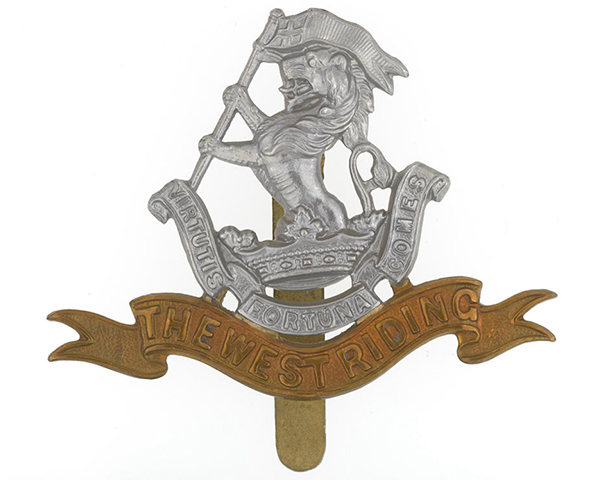
This English regiment has had different names throughout its long history, its creation dating back to the very beginning of the 18th century. In 1782 it was associated with the County of Yorkshire (central England) and more precisely with its western part (“West Riding12Historically the region of Yorkshire has been divided into 3 “ridings”, North, East and West. The term “riding” comes from an old Viking word meaning “third”.”, which still appears in its name).
In 1853, Queen Victoria ordered that the regiment be named after the Duke of Wellington13Arthur Wellesley (1769–1852), Duke of Wellington, British soldier and statesman; he was the winner of Waterloo. , who had just died and had served in this unit.
At the start of the Second World War, the Duke of Wellington’s Regiment (West Riding) comprised several battalions, engaged in different theaters of operations: defense of English territory, Iceland, Battle of France including Dunkirk.In order to strengthen the regiment for the war, two of its battalions, the 6th and 7th, had been duplicated; the new reserve units created taking the name of battalions 2/6th and 2/7th. These two battalions were integrated into the 137th brigade of the 46th infantry division (approximately 16,000 men). The 46th Division landed in France in April 1940, was sent west for various jobs before being called north to the front. In this movement towards the north, disrupted by the German offensive, the 2/7th battalion was cut off from the rest of the division and remained in the Dieppe region. The 2/7th battalion (approximately 800 men) was then operationally integrated into the 51st Highland Division.
The fighting in Blosseville
As indicated above, the Allied command had decided to set up a defensive organisation around Saint-Valery, capable of containing German attacks and thus covering the embarkation of as many men as possible towards England. An arc of a circle with a radius of 10 to 15 km is therefore delimited, from the immediate east of Veules-les-Roses to the west near Saint-Valery. From one side to the other, troops must be positioned on this arc, on the outskirts of villages or hamlets distant of a few kilometers; from east to west: Blosseville, Silleron, Angiens, Houdetot, Ermenouville, Sainte-Colombe, Crasville-la-Mallet, Ocqueville, Saint-Riquier-ès-Plains, Saint-Sylvain.
These defense positions are given to different French or British units. The 2/7th battalion of the Duke of Wellington’s Regiment was responsible for holding the Blosseville position.

Defense system around Saint-Valery-en-Caux and Veules-les-Roses. Sectors allocated to French (purple outline) and British (blue outline) units. We see on this map that the territory of Blosseville had been assigned mainly to the 2/7th Duke of Wellington’s Regiment and for its eastern limit to the 4th Seaforth of the 51st Highland Division.
On June 11 in the early hours of the morning, the battalion arrived on site, transported by trucks after having fought the day before in the area around Dieppe. It covers the area north of Blosseville from the Dieppe road (D925) to the Chapelle sur Dun road (D69).
It is in connection with the units holding the other sectors:
• To the west, the 12th regiment of horse hunters (belonging to the 5th light cavalry division)
• To the east to the Chapelle-sur-Dun, in the plain of Iclon, the 4th Seaforth, battalion of the 51st Highland Division
• Southwest the 5th Gordon Highlanders, also Battalion of the 51st Highland Division
Further south, another battalion of the 51st Highland Division, the 1st Black Watch held the positions of Silleron and Houdetot. French soldiers from the 31st and 40th Infantry Divisions are also located in places near Blosseville: these divisions include the Alpine infantry units (BCA) to which the French soldiers killed at Blosseville belonged.
By late morning on June 11, the defense organisation was in place.But very quickly, the German troops were there and surrounded the place: the tanks of the Panzer Division, the 5th to the east, the 7th to the west as well as the 2nd motorised infantry division to the south. There is therefore no time to install real defense works.
From the afternoon, supported by several dive bombings from its air force, the German army went on the attack, notably at Blosseville as reported by Hervé Savary15Article in Courrier Cauchois March 30, 2023.: “Around 4:30 p.m. many tanks emerged from a woodland to the SW of La Chapelle-sur-Dun. Some attacked the British in front of Blosseville, others crossed the road to Dieppe and deployed, spraying the ground with incendiary bullets which set fire to stacks of straw”.
Despite the bravery of the Allied troops who still had hope of being evacuated by boat, the situation became untenable.Also, on the night of June 11 to 12, the units around Blosseville received orders to leave their positions. The 4th Seaforth Battalion joined the Saint-Valery-en-Caux station. The survivors of the 2/7th Duke of Wellington’s Regiment must go to the beach at Veules-les-Roses in order to embark. They were mostly successful and reached England aboard the requisitioned ferry “Duke of York” to continue the war. However, the battalion left more than 80 dead in the fighting and nearly a hundred of its men were taken prisoner.
The British war graves in Blosseville
Eight British soldiers, who died in the territory of Blosseville, rest in the village cemetery. Today, their burial sites are marked with white headstones placed on a bed of gravel.
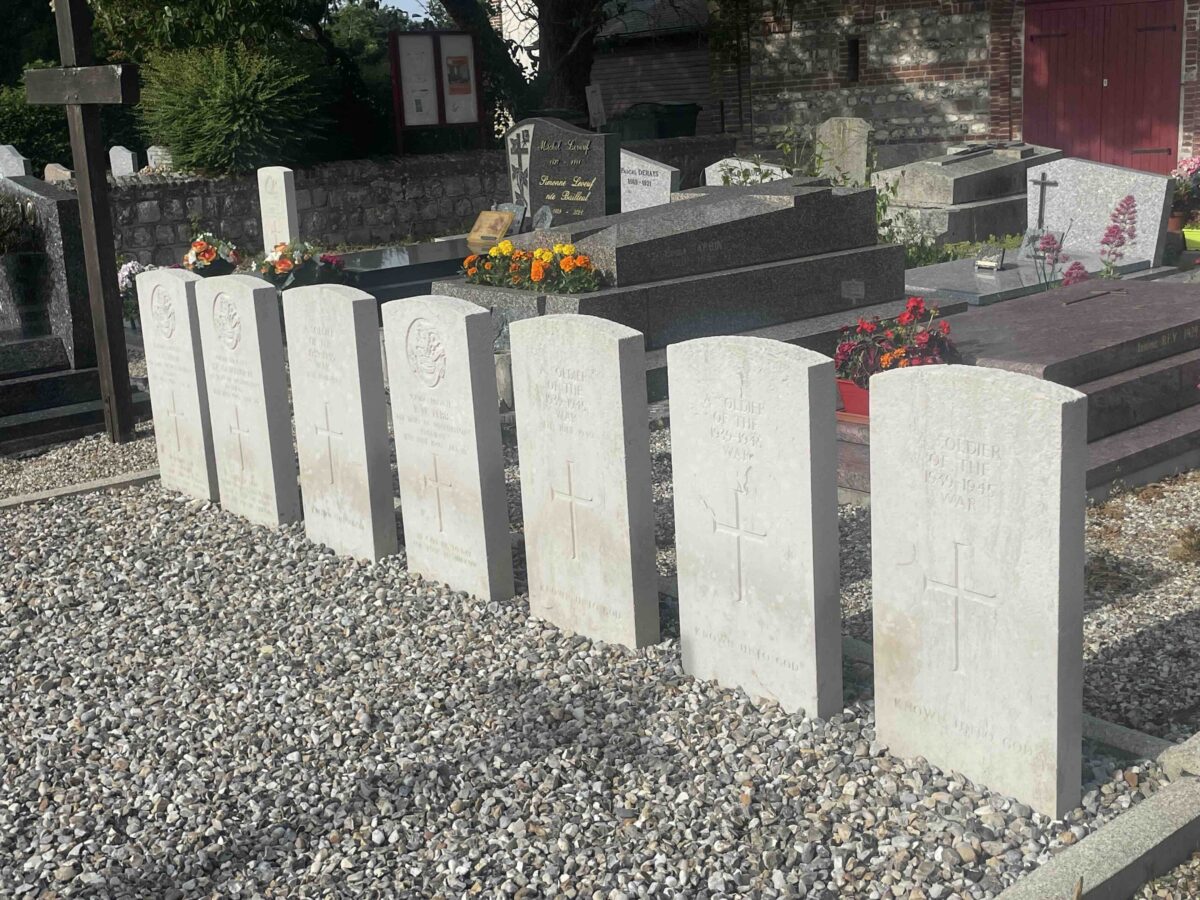
7 grouped in the foreground, 1 isolated in the back (same shape, on the left near the cemetery wall).
After the burials, the tombs have been of different aspects preceding the present headstones.
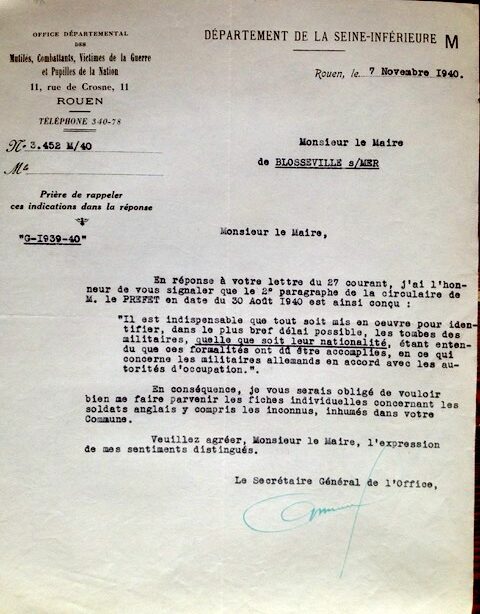
From August 1940, a prefectural circular ordered municipalities to identify the graves of soldiers of all nationalities on their territory.
The mayor of Blosseville was reminded of this circular by a letter from the departmental administration dated November 1940. He was asked to carry out this census of the graves and to transmit the individual files of the British soldiers buried in the village, including those unknown (see opposite).
It was therefore probably from this period that a plan for soldiers’ graves was drawn up by the municipality of Blosseville.
.
.
.
.
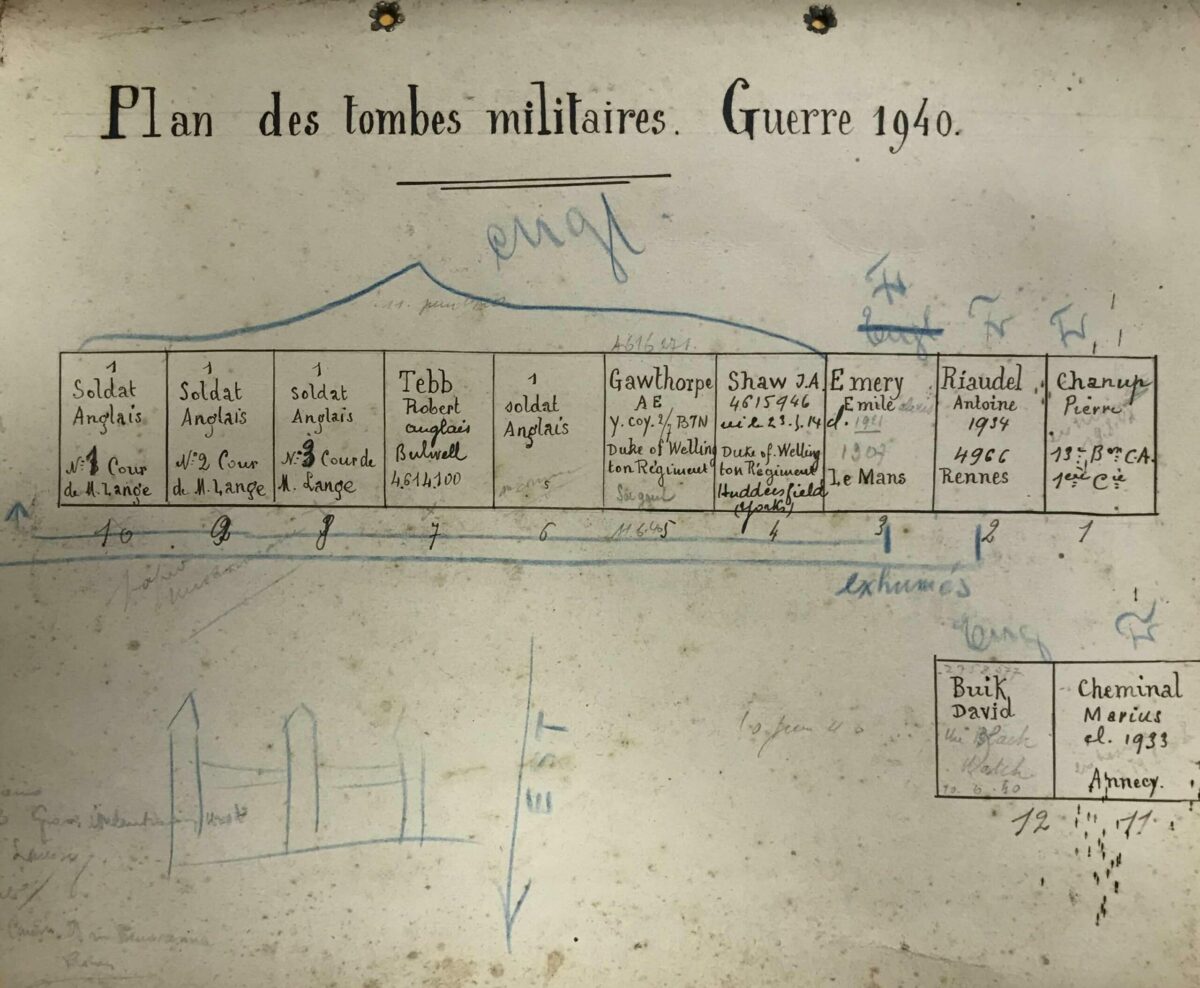
As indicated by the blue arrow, East is down.
We can see the two tombs of David Buick and Marius Cheminal.
Indeed the plan opposite responds to the administration’s request. It gives the locations of the graves as well as some partial information on the British soldiers.
This plan shows us that the burials were divided into two groups, one of 10, the other of 2; the latter corresponds to the soldiers who died “at the manor16The “Manor” is located opposite the cemetery. During the battle of 1940, soldiers wounded in Blosseville or elsewhere were brought there for treatment. » then subsequently buried in the cemetery, David Buick and Marius Cheminal. After the repatriation of the latter’s body to Savoie (France) in 1948, the war grave of soldier Buick therefore remained isolated.
.
.
.
As for the appearance of the burials at the time, a photo taken in September 1947 provides information: it shows a row of wooden crosses, white or light-colored. This is the group of 10 noted on the plan; French soldiers were buried alongside the British before their bodies were transferred to the villages where they were originated from, in 1948.
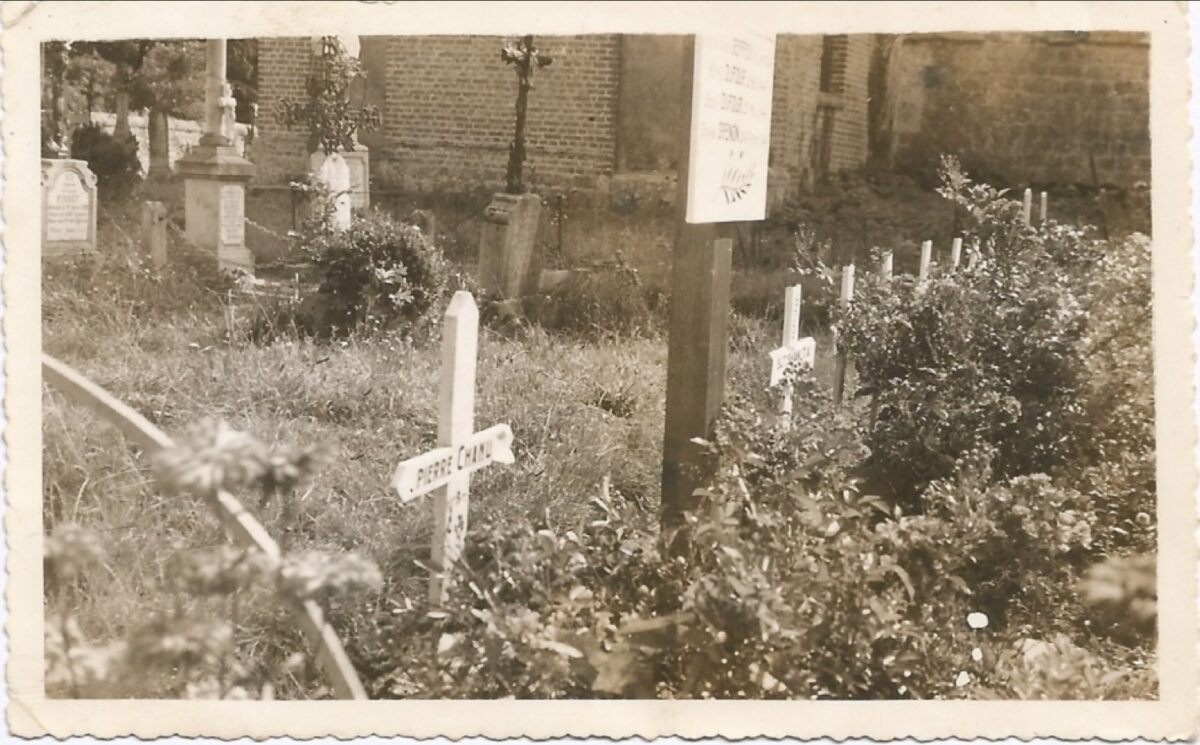
(handwritten letter dated September 23, 1947 sent by the family whom we thank)
These military graves were regularly honored: in April 1944, before the liberation, the municipal council voted a supplement to the budget of “1000 francs for the purchase of flowers for the military graves”. At the meeting of June 19, 1946, the council decided to have the crosses repainted before the visit of a Scottish delegation (see below).
A specialised body of the British Army in charge of regrouping graves had been created and for the Caux region was established in Limésy.
This Imperial British Military Graves Commission then replaced the first wooden crosses with metal crosses painted in grey. The number was drawn in black on the upper vertical post while the initial of the first name, the last name and the regiment were in capital letters on the horizontal bar17Reference H. Savary July 3, 2023..
These metal crosses gave way to the current stone steles in 1951. Two documents demonstrate this:
• a letter from July 1950 from the Commission to the mayor of Blosseville (see below left) announcing the future erection of steles with a concrete surround.• a deliberation of the Municipal Council of Blosseville dated December 1951 (see below on the right); the municipality gives to the French State, without time limit, a piece of land of 11m2 to install the British military graves.

approving the transfer of 11m2 of cemetery land to build British military graves.

to the Mayor of Blosseville dated July 1950. It announces the future erection of headstones with a concrete surround.
Since then, like all military graves on French territory, they have been regularly maintained by the « Commonwealth War Graves Commission » (name taken by the « Imperial War Graves Commission » since 1960).


Four of these British graves do not have names (see photo left). In 1951, these soldiers had not been identified; their headstones mention them as “Known unto God”.
But since then the identity of a soldier has been established, Reynolds (see below); we do not know under which stele he rests.
.
.
So there are:
– three unidentified soldiers
– five soldiers identified: Buick, Reynolds, Shaw, Gawthorpe, Tebb
.
.
.
.
Three unidentified soldiers
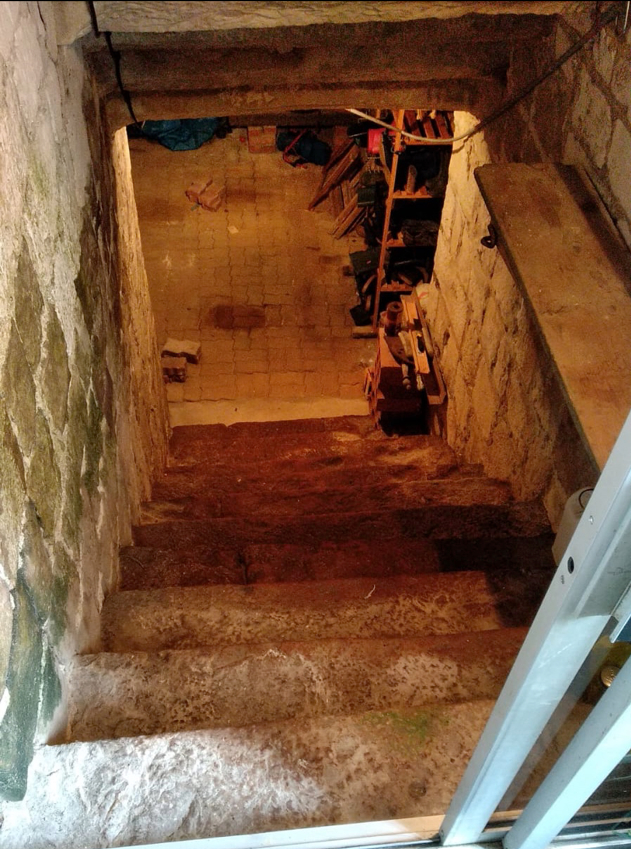
If we rely on the document above, these soldiers were found dead in the Lange farm (located on today’s rue des Bertagnes). According to the memories of Mr P. Gauthier (1932-2023), then a child, two were in the kitchen and one in the cellar. They were most likely first buried elsewhere than in the cemetery.
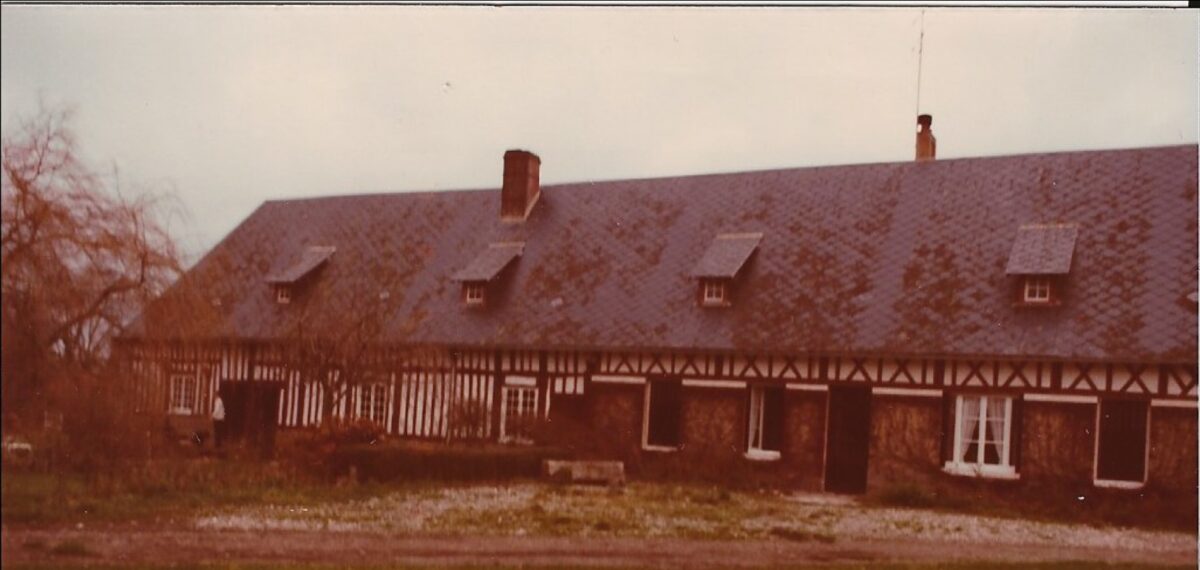
Five identified soldiers
Two belonged to the 51st Highland Division and died in Blosseville from their wounds, probably received a little away from the village, where their units were.David Buick, of the 1st Black Watch, died at the Manor where a “field ambulance” had been installed. His stele tells us that he was a “private” (2nd class soldier) and was 21 years old. He was killed on June 10. On the stone is engraved the badge of his regiment, which represents Saint Andrew, patron of Scotland, behind his cross18Quite coincidentally, the Blosseville cemetery therefore contains two representations of Saint Andrew located less than 10 meters but more than 300 years from each other: that of the tomb of soldier Buick (1951) and that of the « Croix Dyel » – Dyel cross (1626), erected by André Dyel. They both face west.. The regiment’s motto is “Nemo me impune lacessit” (No one attacks me with impunity). As early as June 1942, the International Committee of the Red Cross of Geneva had written to the mayor to request information about David Buick.


Blason Black Watch : Saint Andrew Cross
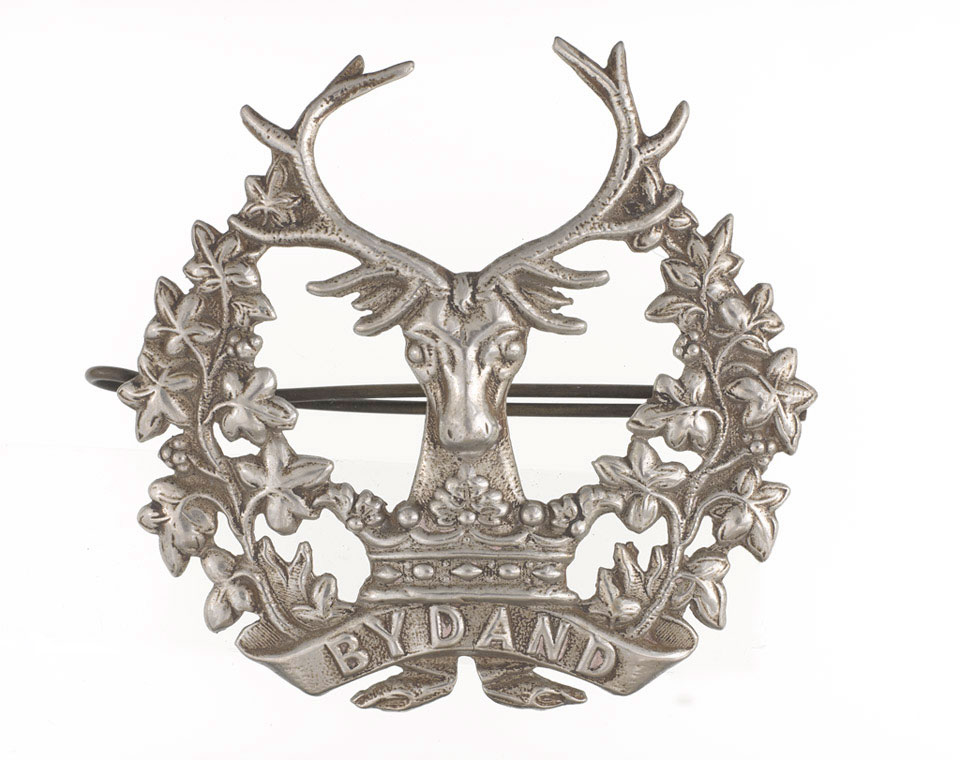
The motto Bydand comes from the Scottish
“Byde and Fecht” means “Hold and Fight” »
James Reynolds, of the 5th Gordon Highlanders Battalion (51st Highland Division), does not have his name engraved on a tomb. Indeed he was identified very late thanks to a casualty note – see below -; this document indicates that Private Reynolds was initially buried behind the town hall. It is therefore probably one of the 4 headstones of unknown soldiers, perhaps the fifth from the church wall. He was a private from Aberdeen, aged 22.

« Father 21 Short Loanings Aberdeen Reputed dead Blosseville & buried behind town hall »
Three soldiers belonged to the 2/7th Duke of Wellington (West Riding) Regiment
On their steles appear the coat of arms and the motto of the regiment, inherited from the arms of the Duke of Wellington. The coat of arms represents a lion holding a flag above a ducal crown. The motto “Virtutis fortuna comes” literally translates as “Fortune companion of virtue” with the meaning of “fortune favours the bold”. The mention “West Riding” is not included on the steles. These three soldiers are:
Terence Ambler Shaw, “serjeant”19A “serjeant” was a non-commissioned officer in charge of around thirty soldiers., 26 years old, “youngest son of the late Arthur and Lucy Shaw, Huddersfield, Yorkshire, England”.
Herbert Edward Gawthorpe, serjeant, 20 years old. At the bottom of the stele, the inscription is taken from the Gospel of Saint John (15-13); “ Greater love hath no man than this. That a man lay down his life for his friends.
”Robert Wallace Tebb, « private », 19 years old. At the bottom of the stele is written: “He gave his today for your tomorrow”. He was the son of Wallace and Hilda Tebb of Charlton, London. However, the handwritten note on the post-war cemetery drawing (see above) mentions Bulwell, a town very close to Nottingham, closer to the Yorkshire region.

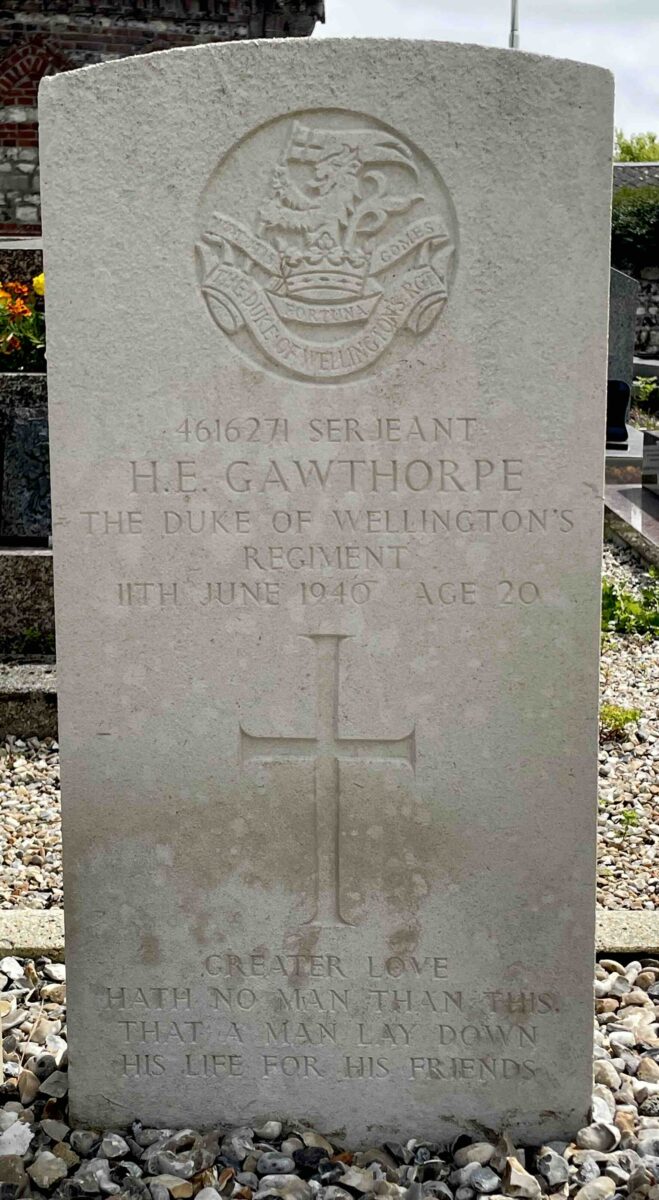

……………Headstone T.A. Shaw …………….Headstone H.E. Gawthorpe……………….Headstone R.W. Tebb
Commemorations
Tributes are regularly paid to the soldiers who fell in Blosseville, during ceremonies organized by the town hall and the Veterans’ Association (current “Association Blossevillaise Mémorielle”), on the anniversaries of the armistice.
The gathered inhabitants bow in front of the headstones of the British soldiers.
On certain occasions, British delegations are present. We mention here the oldest (1946), that of 1990 and the two most recent (2023 and 2025). In July 1946, the mayors (“Provosts”) of three Scottish towns, Inverness, Elgin and Aberdeen, went to Saint-Valery-en-Caux and the surrounding villages, on July 7 in Blosseville. The local newspaper reported these ceremonies.
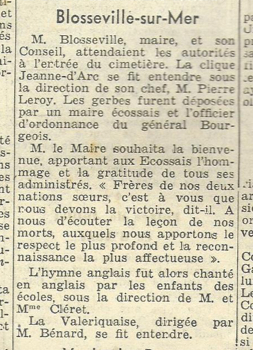
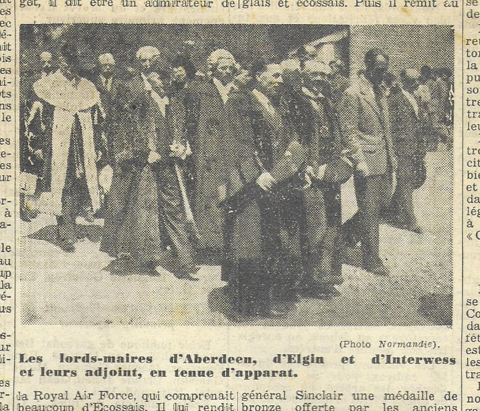
Their signatures appear on the commemorative document decorated by the Veulais painter Camille Marchand. Created for this occasion, this painting is still present in the office of the mayor of Blosseville.

Every year, the people of Blosseville pay tribute to the British soldiers. An example from 1990:
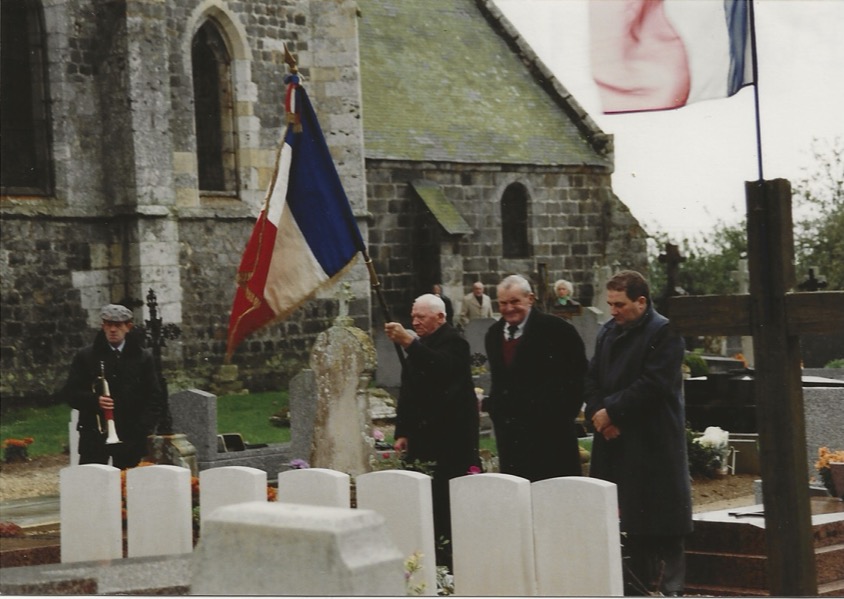
Joseph Leriche (flag bearer), Paul Renaux, Jean Callens (mayor)
In 2023, the commemoration replaced that of the 80th anniversary which could not be held due to the covid epidemic. Organized by the Communauté de Communes de la Côte d’Albâtre and the municipality of Blosseville, it was held in the presence of a large English and Scottish delegation. French and British soldiers were honoured. An exhibition in the school covered playground retraced their stories.
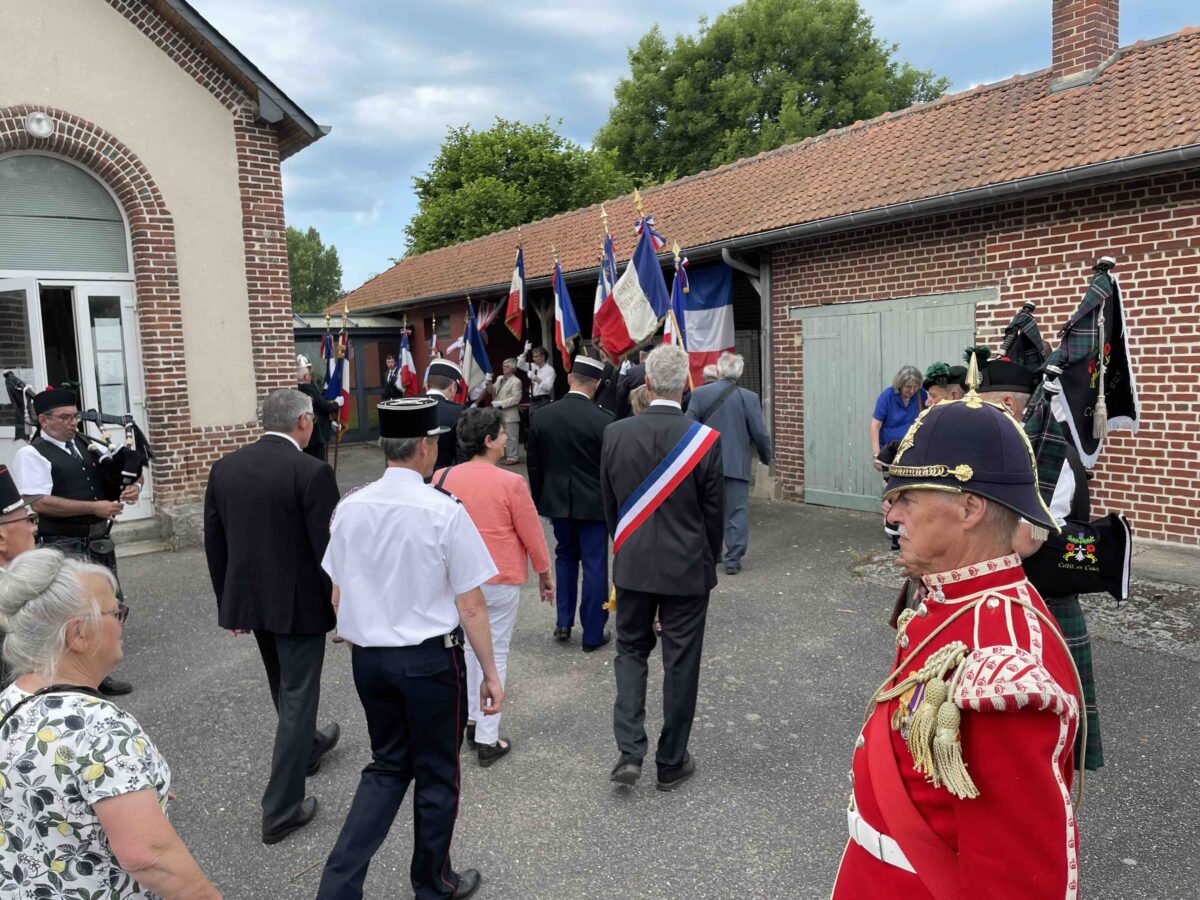
Officials heading towards the exhibition.
Foreground right: David Barlow,
« Drum Sergeant/Bugler » – Yorkshire Volunteers Corps of Drums

.
In 2025, for the 85th anniversary of the fighting of 1940, the commemoration includes a tribute in the cemetery then a parade towards the Jardin du Val (“ Carrefour du Calvaire “). It is this location that has been chosen to welcome a metal silhouette of a soldier from the 2/7th Duke of Wellington (West Riding) Regiment; this is part of a memorial route set up by the Communauté de Communes de la Côte d’Albâtre.
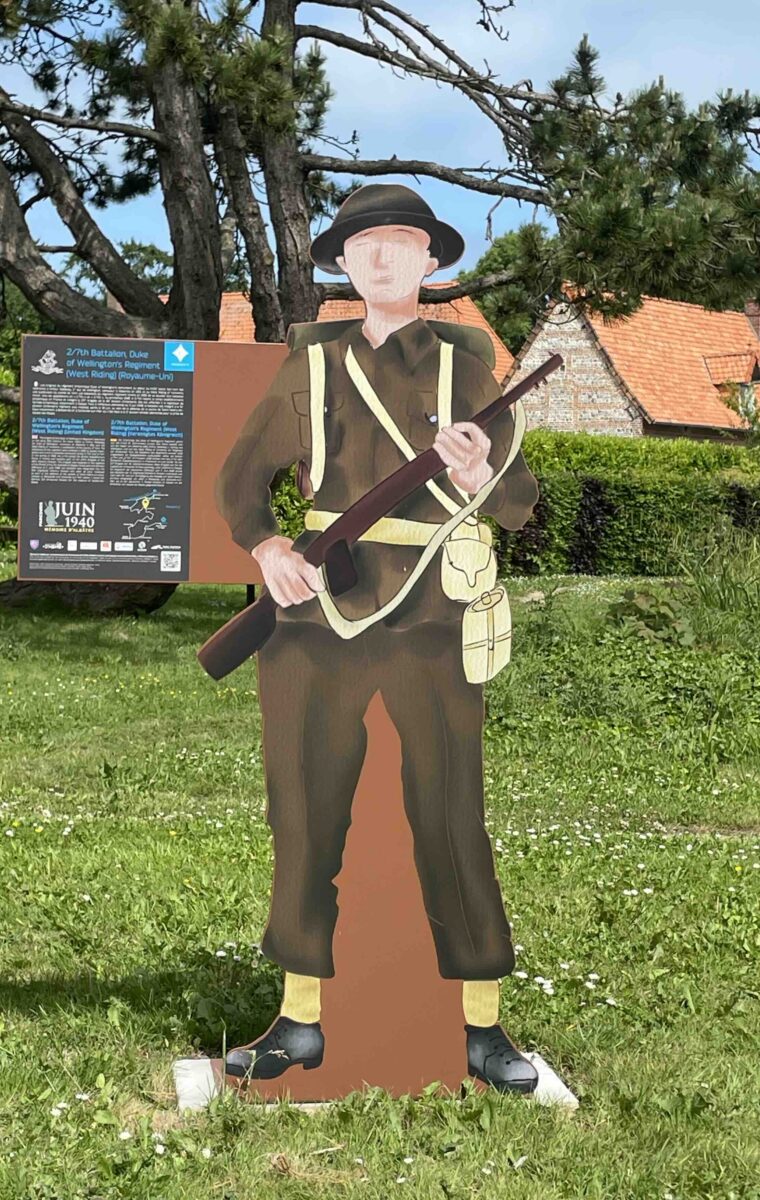
Références
- 1The installation of this plaque was done by the municipality of Blosseville. This initiative, also carried out in other municipalities, follows the resolute and persevering action of Mr Hervé Savary for the memory of the fighting on Norman soil.
- 2Catherine Tardif « Qui se souvient des soldats de Juin 1940 » ? – Who remembers the soldiers of June 1940? – l’Echo du Vent – July 2013 pp. 5-6.
- 3The British Expeditionary Force is the name given to all the British armed forces sent from the fall of 1939 to the Franco-Belgian border. In May 1940, it was made up of 10 infantry divisions (more than 390,000 men), an armored brigade and 500 aircraft (source National Army Museum).
- 4Nearly 340,000 men were rescued from Dunkirk between May 26 and June 4: around 200,000 British, 120,000 French and nearly 20,000 Belgians (source https://simple.wikipedia.org/wiki/Dunkirk_evacuation). 20,000 Allied soldiers were killed and 40,000 were taken prisoner.
- 5Cf. Book by R.G. Nobécourt – The soldiers of 40 in the first battle of Normandy – Editions Bertout 1986 – See Chapter IV, p. 185
- 62137 British and 1184 French soldiers have been evacuated. Nearly 1000 soldiers were killed, 46,000 were taken prisoner (38,000 French, 8,000 British).
- 7The 51st Highland Division takes its name from the Highlands, a region located in the northwest of Scotland. The main town is Inverness.
- 8Seaforth is an island of the United Kingdom located in Scotland in the Outer Hebrides.
- 9Cameron is the name of a Scottish Highland clan. According to Wikipedia, a clan is a group of families associated by real or fictitious kinship, based on the idea of descent from a common ancestor.
- 10The Black Watch regiment (“Black Guard”) is the oldest of the Highland regiments. It would take its name “Guard” from its role in maintaining order in Scotland when it was created in the 18th century, and that of “black” from the dark color of its tartan.
- 11Gordon is the name of a Scottish clan.
- 12Historically the region of Yorkshire has been divided into 3 “ridings”, North, East and West. The term “riding” comes from an old Viking word meaning “third”.
- 13Arthur Wellesley (1769–1852), Duke of Wellington, British soldier and statesman; he was the winner of Waterloo.
- 14Marc Tabone – Veules – June 1940, Ecossais et Français pris au piège – Comever Rameau Editor – New edition 2015
- 15Article in Courrier Cauchois March 30, 2023.
- 16The “Manor” is located opposite the cemetery. During the battle of 1940, soldiers wounded in Blosseville or elsewhere were brought there for treatment.
- 17Reference H. Savary July 3, 2023.
- 18Quite coincidentally, the Blosseville cemetery therefore contains two representations of Saint Andrew located less than 10 meters but more than 300 years from each other: that of the tomb of soldier Buick (1951) and that of the « Croix Dyel » – Dyel cross (1626), erected by André Dyel.
- 19A “serjeant” was a non-commissioned officer in charge of around thirty soldiers.

